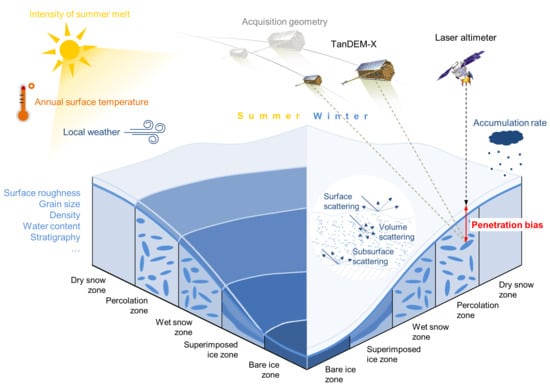Estimating Penetration-Related X-Band InSAR Elevation Bias: A Study over the Greenland Ice Sheet
Abstract
1. Introduction
1.1. Motivation
1.2. Conceptual Framework
2. Study Area
3. Datasets
3.1. TanDEM-X Elevation Data
3.2. ICESat Data
3.3. IceBridge Data
4. Methods
4.1. Pre-Processing
4.1.1. Preparation and Adjustment of Interferometric Coherence
4.1.2. Radiometric Calibration of Backscatter Intensity
4.1.3. Height Calibration
4.2. Estimation of X-Band Penetration Bias
4.3. Elevation Change
5. Results
5.1. Estimation of X-Band Penetration Bias
5.2. Elevation Change
6. Discussion
7. Conclusions
Author Contributions
Funding
Acknowledgments
Conflicts of Interest
References
- Nghiem, S.V.; Hall, D.K.; Mote, T.L.; Tedesco, M.; Albert, M.R.; Keegan, K.; Shuman, C.A.; DiGirolamo, N.E.; Neumann, G. The extreme melt across the Greenland ice sheet in 2012. Geophys. Res. Lett. 2012, 39, 6. [Google Scholar] [CrossRef]
- Tedesco, M.; Fettweis, X.; Mote, T.; Wahr, J.; Alexander, P.; Box, J.E.; Wouters, B. Evidence and analysis of 2012 Greenland records from spaceborne observations, a regional climate model and reanalysis data. Cryosphere 2013, 7, 615–630. [Google Scholar] [CrossRef]
- Intergovernmental Panel on Climate Change (IPCC). Climate Change 2013: The Physical Science Basis. Contribution of Working Group I to the Fifth Assessment Report of the Intergovernmental Panel on Climate Change; Stocker, T.F., Qin, D., Plattner, G.K., Tignor, M., Allen, S.K., Boschung, J., Nauels, A., Xia, Y., Bex, V., Midgley, P.M., Eds.; Cambridge University Press: Cambridge, UK; New York, NY, USA, 2013. [Google Scholar]
- Tedesco, M. Snowmelt detection over the Greenland ice sheet from SSM/I brightness temperature daily variations. Geophys. Res. Lett. 2007, 34, 6. [Google Scholar] [CrossRef]
- Shepherd, A.; Ivins, E.R.; Geruo, A.; Barletta, V.R.; Bentley, M.J.; Bettadpur, S.; Briggs, K.H.; Bromwich, D.H.; Forsberg, R.; Galin, N.; et al. A Reconciled Estimate of Ice-Sheet Mass Balance. Science 2012, 338, 1183–1189. [Google Scholar] [CrossRef] [PubMed]
- Flowers, G.E. Hydrology and the future of the Greenland Ice Sheet. Nat. Commun. 2018, 9, 2729. [Google Scholar] [CrossRef] [PubMed]
- Van den Broeke, M.R.; Enderlin, E.M.; Howat, I.M.; Kuipers Munneke, P.; Noël, B.P.; Jan Van De Berg, W.; Van Meijgaard, E.; Wouters, B. On the recent contribution of the Greenland ice sheet to sea level change. Cryosphere 2016, 10, 1933–1946. [Google Scholar] [CrossRef]
- Rignot, E.; Echelmeyer, K.; Krabill, W. Penetration depth of interferometric synthetic-aperture radar signals in snow and ice. Geophys. Res. Lett. 2001, 28, 3501–3504. [Google Scholar] [CrossRef]
- Jawak, S.D.; Bidawe, T.G.; Luis, A.J. A Review on Applications of Imaging Synthetic Aperture Radar with a Special Focus on Cryospheric Studies. Adv. Remote Sens. 2015, 4, 163–175. [Google Scholar] [CrossRef]
- Joughin, I.; Smith, B.E.; Abdalati, W. Glaciological advances made with interferometric synthetic aperture radar. J. Glaciol. 2010, 56, 1026–1042. [Google Scholar] [CrossRef]
- Khan, S.A.; Aschwanden, A.; Bjørk, A.A.; Wahr, J.; Kjeldsen, K.K.; Kjaer, K.H. Greenland ice sheet mass balance: A review. Rep. Prog. Phys. 2015, 78, 046801. [Google Scholar] [CrossRef]
- Krieger, G.; Zink, M.; Bachmann, M.; Bräutigam, B.; Schulze, D.; Martone, M.; Rizzoli, P.; Steinbrecher, U.; Antony, J.W.; De Zan, F.; et al. TanDEM-X: A radar interferometer with two formation-flying satellites. Acta Astronaut. 2013, 89, 83–98. [Google Scholar] [CrossRef]
- Rizzoli, P.; Martone, M.; Gonzalez, C.; Wecklich, C.; Tridon, D.B.; Bräutigam, B.; Bachmann, M.; Schulze, D.; Fritz, T.; Huber, M.; et al. Generation and performance assessment of the global TanDEM-X digital elevation model. ISPRS J. Photogramm. Remote Sens. 2017, 132, 119–139. [Google Scholar] [CrossRef]
- Martone, M.; Rizzoli, P.; Krieger, G. Volume Decorrelation Effects in TanDEM-X Interferometric SAR Data. IEEE Geosci. Remote Sens. Lett. 2016, 13, 1812–1816. [Google Scholar] [CrossRef]
- Rignot, E.; Jezek, K.; Van Zyl, J.J.; Drinkwater, M.R.; Lou, Y.L. Radar scattering from snow facies of the Greenland ice sheet: Results from the AIRSAR 1991 campaign. In Proceedings of the IEEE International Geoscience and Remote Sensing Symposium (IGARSS), Tokyo, Japan, 18–21 August 1996. [Google Scholar]
- Hoen, E.W.; Zebker, H.A. Penetration depth inferred from interferometric volume decorrelation observed over the Greenland ice sheet. IEEE Trans. Geosci. Remote Sens. 2000, 38, 2571–2583. [Google Scholar]
- Dall, J. InSAR Elevation Bias Caused by Penetration into Uniform Volumes. IEEE Trans. Geosci. Remote Sens. 2007, 45, 2319–2324. [Google Scholar] [CrossRef]
- Oveisgharan, S.; Zebker, H.A. Estimating Snow Accumulation from InSAR Correlation Observations. IEEE Trans. Geosci. Remote Sens. 2007, 45, 10–20. [Google Scholar] [CrossRef]
- Stebler, O.; Schwerzmann, A.; Luthi, M.; Meier, E.; Nuesch, D. Pol-InSAR Observations from an Alpine Glacier in the Cold Infiltration Zone at L- and P-Band. IEEE Geosci. Remote Sens. Lett. 2005, 2, 357–361. [Google Scholar] [CrossRef]
- Fischer, G.; Papathanassiou, K.P.; Hajnsek, I. Modeling Multifrequency Pol-InSAR Data from the Percolation Zone of the Greenland Ice Sheet. IEEE Trans. Geosci. Remote Sens. 2018, 57, 1963–1976. [Google Scholar] [CrossRef]
- Fahnestock, M.; Bindschadler, R.; Kwok, R.; Jezek, K. Greenland Ice Sheet Surface Properties and Ice Dynamics from ERS-1 SAR Imagery. Science 1993, 262, 1530–1534. [Google Scholar] [CrossRef]
- Gray, L.; Burgess, D.; Copland, L.; Demuth, M.N.; Dunse, T.; Langley, K.; Schuler, T.V. CryoSat-2 delivers monthly and inter-annual surface elevation change for Arctic ice caps. Cryosphere 2015, 9, 1895–1913. [Google Scholar] [CrossRef]
- Falk, U.; Gieseke, H.; Kotzur, F.; Braun, M. Monitoring snow and ice surfaces on King George Island, Antarctic Peninsula, with high-resolution TerraSAR-X time series. Antarct. Sci. 2016, 28, 135–149. [Google Scholar] [CrossRef]
- Rizzoli, P.; Martone, M.; Rott, H.; Moreira, A. Characterization of snow facies on the Greenland ice sheet observed by TanDEM-X interferometric SAR Data. Remote Sens. 2017, 9, 315. [Google Scholar] [CrossRef]
- Matzler, C. Microwave Properties of Ice and Snow. In Solar System Ices, Astrophysics and Space Science Library; Schmitt, B., De Bergh, C., Festou, M., Eds.; Springer: Dordrecht, The Netherlands, 1998; Volume 227, pp. 241–257. [Google Scholar]
- Liu, H.; Wang, L.; Jezek, K.C. Automated Delineation of Dry and Melt Snow Zones in Antarctica Using Active and Passive Microwave Observations from Space. IEEE Trans. Geosci. Remote Sens. 2006, 44, 2152–2163. [Google Scholar]
- Benson, C.S. Stratigraphic Studies in the Snow and Firn of the Greenland Ice Sheet. Rese. Rep. 1962, 70, 1–8. [Google Scholar]
- Munk, J.; Jezek, K.C.; Forster, R.R.; Gogineni, S.P. An accumulation map of the Greenland dry-snow facies derived from spaceborne radar. J. Geophys. Res. 2003, 108, 1–12. [Google Scholar] [CrossRef]
- Abdullahi, S.; Wessel, B.; Leichtle, T.; Huber, M.; Wohlfart, C.; Roth, A. Investigation of TanDEM-X Penetration Depth over the Greenland Ice Sheet. In Proceedings of the IEEE International Geoscience and Remote Sensing Symposium (IGARSS), Valencia, Spain, 22–27 July 2018. [Google Scholar]
- Partington, K. Discrimination of glacier facies using multi-temporal SAR data. J. Glaciol. 1998, 44, 42–53. [Google Scholar] [CrossRef]
- König, M.; Wadham, J.; Winther, J.G.; Kohler, J.; Nuttall, A.M. Detection of superimposed ice on the glaciers Konsvegen and midre Lovénbreen, Svalbard, using SAR satellite imagery. Ann. Glaciol. 2002, 34, 335–342. [Google Scholar] [CrossRef]
- Rignot, E.J.; Ostro, S.J.; Van Zyl, J.J.; Jezek, K.C. Unusual radar echoes from the Greenland ice sheet. Science 1993, 261, 1710–1713. [Google Scholar] [CrossRef]
- Christoffersen, P. Greenland Ice Sheet. In Encyclopedia of Snow, Ice and Glaciers; Singh, V.P., Singh, P., Haratashya, U.K., Eds.; Springer Science + Business Media B. V.: Dordrecht, The Netherlands, 2011; pp. 484–488. [Google Scholar]
- Bamber, J.L.; Griggs, J.A.; Hurkmans, R.T.; Dowdeswell, J.A.; Gogineni, S.P.; Howat, I.; Mouginot, J.; Paden, J.; Palmer, S.; Rignot, E.; et al. A new bed elevation dataset for Greenland. Cryosphere 2013, 7, 499–510. [Google Scholar] [CrossRef]
- Steffen, K.; Box, J. Surface climatology of the Greenland Ice Sheet: Greenland Climate Network 1995–1999. J. Geophys. Res. 2001, 106, 33951–33964. [Google Scholar] [CrossRef]
- Krieger, G.; Moreira, A.; Fiedler, H.; Hajnsek, I.; Werner, M.; Younis, M.; Zink, M. TanDEM-X: A Satellite Formation for High-Resolution SAR Interferometry. IEEE Trans. Geosci. Remote Sens. 2007, 45, 3317–3337. [Google Scholar] [CrossRef]
- Gruber, A.; Wessel, B.; Martone, M.; Roth, A. The TanDEM-X DEM Mosaicking: Fusion of Multiple Acquisitions Using InSAR Quality Parameters. IEEE J. Sel. Top. Appl. Earth Obs. Remote Sens. 2016, 9, 1047–1057. [Google Scholar] [CrossRef]
- Lachaise, M.; Fritz, T.; Bamler, R. The Dual-Baseline Phase Unwrapping Correction Framework for the TanDEM-X Mission Part1: Theoretical Description and Algorithms. IEEE Trans. Geosci. Remote Sens. 2018, 2, 780–798. [Google Scholar] [CrossRef]
- Fritz, T.; Rossi, C.; Yague-Martinez, N.; Rodriguez-Gonzalez, F.; Lachaise, M.; Breit, H. Interferometric processing of TanDEM-X data. In Proceedings of the IEEE International Geoscience and Remote Sensing Symposium, Vancouver, BC, Canada, 24–29 July 2011. [Google Scholar]
- Gruber, A.; Wessel, B.; Huber, M.; Roth, A. Operational TanDEM-X DEM calibration and first validation results. ISPRS J. Photogramm. Remote Sens. 2012, 73, 39–49. [Google Scholar] [CrossRef]
- Wessel, B.; Bertram, A.; Gruber, A.; Bemm, S.; Dech, S. A new high resolution elevation model of Greenland derived from TanDEM-X. In Proceedings of the ISPRS Annals of the Photogrammetry, Remote Sensing and Spatial Information Sciences, XXIII ISPRS Congress, Prague, Czech Republic, 12–19 July 2016. [Google Scholar]
- Zwally, H.; Schutz, R.; Bentley, C.; Bufton, J.; Herring, T.; Minster, J.; Spinhirne, J.; Thomas, R. GLAS/ICESat L2 Global Land Surface Altimetry Data; Version 34; February 2003 to October 2009; NASA National Snow and Ice Data Center Distributed Active Archive Center: Boulder, CO, USA, 2014. [Google Scholar] [CrossRef]
- Levinsen, J.F.; Howat, I.M.; Tscherning, C.C. Improving maps of ice-sheet surface elevation change using combined laser altimeter and stereoscopic elevation model data. J. Glaciol. 2013, 59, 524–532. [Google Scholar] [CrossRef]
- Studinger, M. IceBridge ATM L2 Icessn Elevation, Slope, and Roughness, Version 2; March 2011 to May 2012; Updated 2018; NASA National Snow and Ice Data Center Distributed Active Archive Center: Boulder, CO, USA, 2014. [Google Scholar] [CrossRef]
- Moreira, A.; Prats-Iraola, P.; Younis, M.; Krieger, G.; Hajnsek, I.; Papathanassiou, K.P. A tutorial on synthetic aperture radar. IEEE Geosci. Remote Sens. Mag. 2013, 1, 6–43. [Google Scholar] [CrossRef]
- Small, D. Flattening Gamma: Radiometric Terrain Correction for SAR Imagery. IEEE Trans. Geosci. Remote Sens. 2011, 49, 3081–3093. [Google Scholar] [CrossRef]
- Ashcraft, I.S.; Long, D.G. Observation and Characterization of Radar Backscatter over Greenland. IEEE Trans. Geosci. Remote Sens. 2005, 43, 225–237. [Google Scholar] [CrossRef]
- Fritz, T.; Eineder, M. TerraSAR-X Ground Segment Basic Product Specification Document. Clust. Appl. Remote Sens. 2010, TX-GS-DD-3302, 1–109. [Google Scholar]
- Wessel, B. TanDEM-X Ground Segment—DEM Products Specification Document; DLR: Oberpfaffenhofen, Germany, 2018; Available online: https://elib.dlr.de/120422/ (accessed on 20 June 2019).
- Airbus. Radiometric Calibration of TerraSAR-X Data. 2014. Available online: https://spacedata.copernicus.eu/documents/12833/14537/TerraSAR-X_RadiometricCalculations (accessed on 17 June 2019).
- Wohlfart, C.; Wessel, B.; Huber, M.; Leichtle, T.; Abdullahi, S.; Kerkhoff, S.; Roth, A. TanDEM-X DEM derived elevation changes of the Greenland Ice Sheet. In Proceedings of the IEEE International Geoscience and Remote Sensing Symposium (IGARSS), Valencia, Spain, 22–27 July 2018. [Google Scholar]
- Gray, L.; Burgess, D.; Copland, L.; Langley, K.; Gogineni, P.; Paden, J.; Leuschen, C.; van As, D.; Fausto, R.; Joughin, I.; et al. Measuring Height Change Around the Periphery of the Greenland Ice Sheet with Radar Altimetry. Front. Earth Sci. 2019, 7, 146. [Google Scholar] [CrossRef]
- McMillan, M.; Leeson, A.; Shepherd, A.; Briggs, K.; Armitage, T.W.; Hogg, A.; Kuipers Munneke, P.; Van Den Broeke, M.; Noel, B.; van de Berg, W.J.; et al. A high resolution record of Greenland mass balance. Geophys. Res. Lett. 2016, 43, 7002–7010. [Google Scholar] [CrossRef]
- Helm, V.; Humbert, A.; Miller, H. Elevation and elevation change of Greenland and Antarctica derived from CryoSat-2. Cryosphere 2014, 8, 1539–1559. [Google Scholar] [CrossRef]
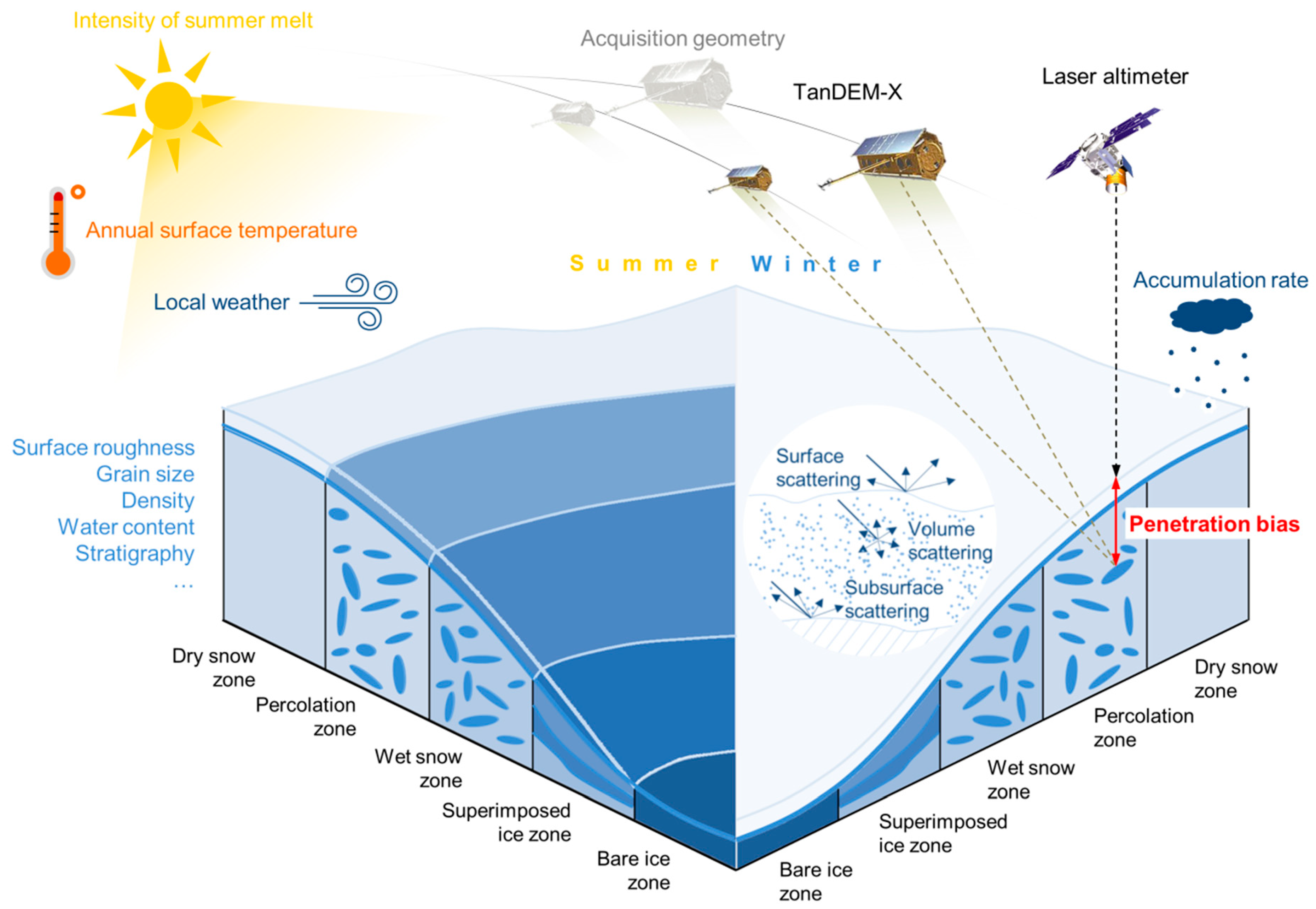
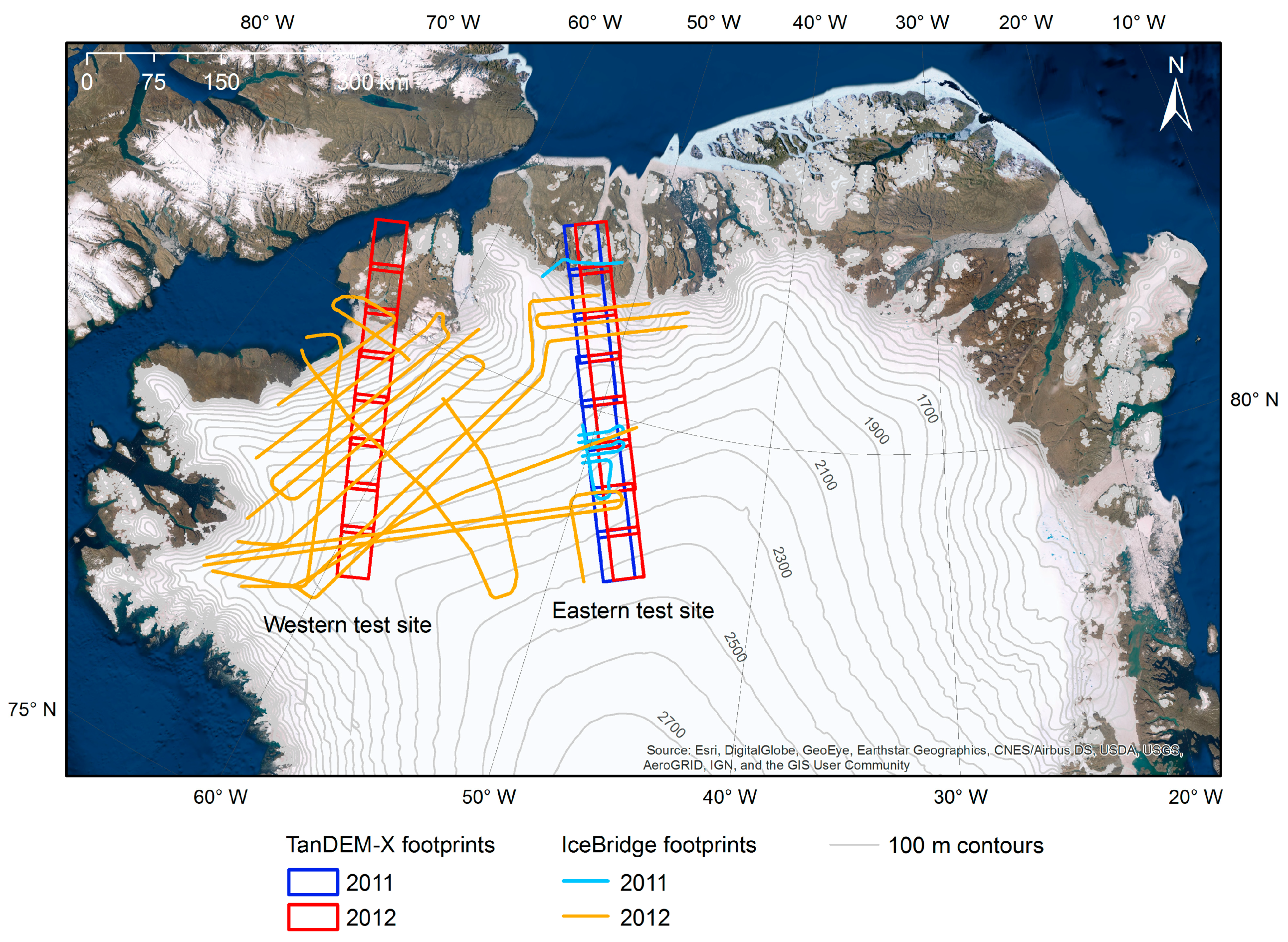
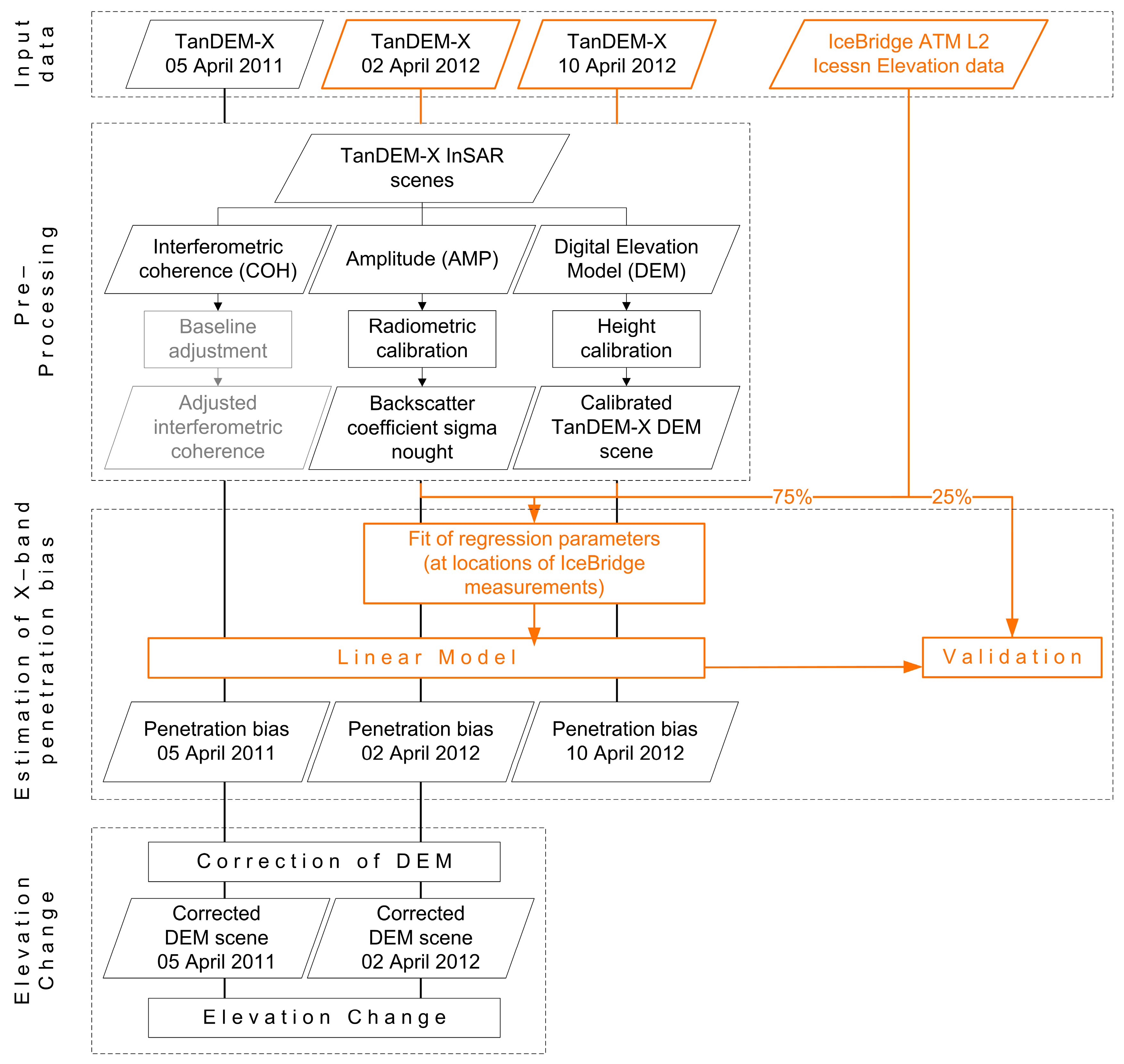

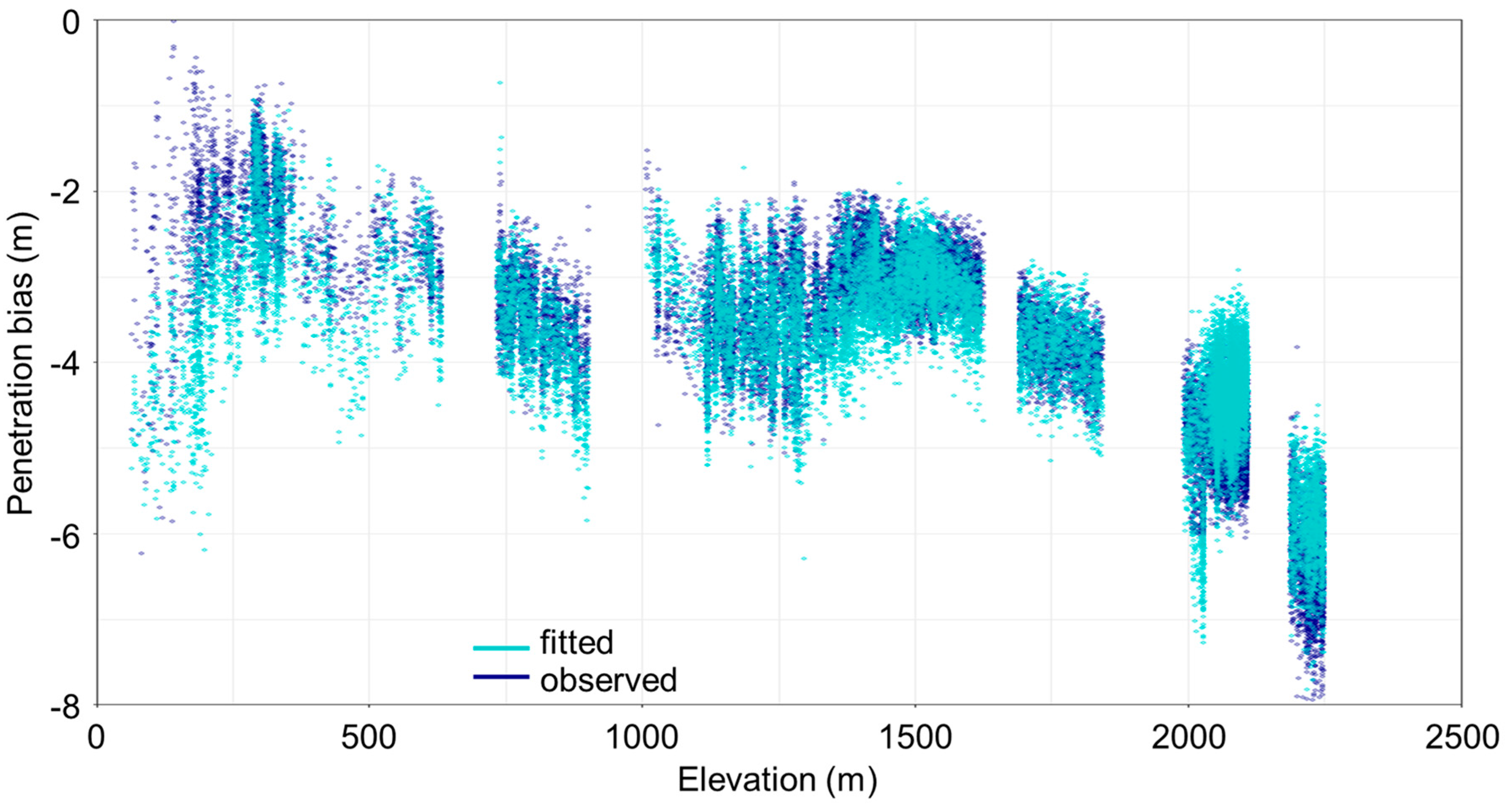




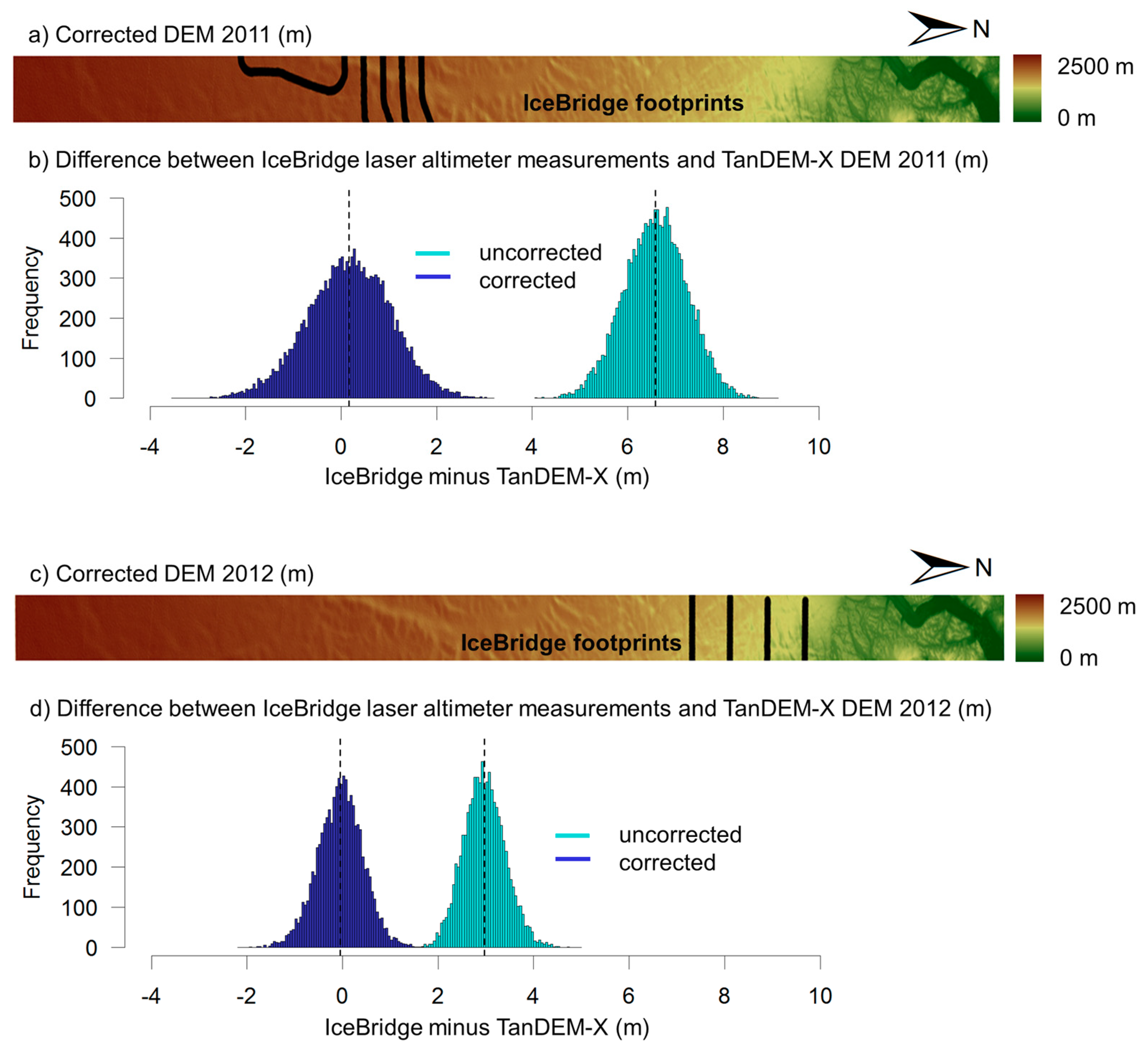

| Acquisition Date | Number of Scenes | Polarization | Orbit | Look Direction | Incidence Angle | Effective Baseline |
|---|---|---|---|---|---|---|
| 5 April 2011 | 8 | HH | Ascending | Right | 40.6–40.6° | 101.9–109.2 m |
| 2 April 2012 | 8 | HH | Ascending | Right | 41.4–41.5° | 178.2–189.2 m |
| 10 April 2012 | 8 | HH | Ascending | Right | 39.4–39.5° | 170.3–182.0 m |
| Parameter | Standard Error | t-Value | Pr (>|t|) |
|---|---|---|---|
| Intercept (a0) | 0.03 | −434.64 | <2e-16 |
| a1 | 0.05 | 338.85 | <2e-16 |
| a2 | 0.001 | −58.68 | <2e-16 |
© 2019 by the authors. Licensee MDPI, Basel, Switzerland. This article is an open access article distributed under the terms and conditions of the Creative Commons Attribution (CC BY) license (http://creativecommons.org/licenses/by/4.0/).
Share and Cite
Abdullahi, S.; Wessel, B.; Huber, M.; Wendleder, A.; Roth, A.; Kuenzer, C. Estimating Penetration-Related X-Band InSAR Elevation Bias: A Study over the Greenland Ice Sheet. Remote Sens. 2019, 11, 2903. https://doi.org/10.3390/rs11242903
Abdullahi S, Wessel B, Huber M, Wendleder A, Roth A, Kuenzer C. Estimating Penetration-Related X-Band InSAR Elevation Bias: A Study over the Greenland Ice Sheet. Remote Sensing. 2019; 11(24):2903. https://doi.org/10.3390/rs11242903
Chicago/Turabian StyleAbdullahi, Sahra, Birgit Wessel, Martin Huber, Anna Wendleder, Achim Roth, and Claudia Kuenzer. 2019. "Estimating Penetration-Related X-Band InSAR Elevation Bias: A Study over the Greenland Ice Sheet" Remote Sensing 11, no. 24: 2903. https://doi.org/10.3390/rs11242903
APA StyleAbdullahi, S., Wessel, B., Huber, M., Wendleder, A., Roth, A., & Kuenzer, C. (2019). Estimating Penetration-Related X-Band InSAR Elevation Bias: A Study over the Greenland Ice Sheet. Remote Sensing, 11(24), 2903. https://doi.org/10.3390/rs11242903




